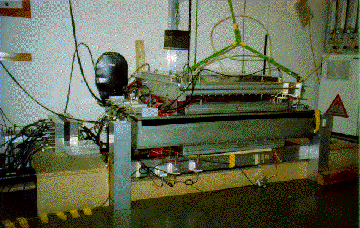



Next: Description of the
Up: Performance and Calibration
Previous: Surface Treatments of
The optical properties of a given calorimeter module are being systematically
studied and must satisfy expectations before the particular module can be
selected for the assembly of the calorimeter. Some of the expectations which
must be met have been described and explained in section 7.6.

Figure: The tomography apparatus contains six crystals
whose positions in the steel box are known to within 1 mm. There are two
drift chambers on top, and one below the box. The active area of the
chambers is  . The lead bricks and the plastic
scintillator counters are hidden in this view.
. The lead bricks and the plastic
scintillator counters are hidden in this view.
The optical properties of interest include the attenuation length of CsI, the
temperature dependence of the light output, the non-uniformity in the
generation and collection of the scintillator light and the ratio of the
fast to total component of the CsI light.
Forty-seven calorimeter crystals have been examined so far with the
tomography apparatus which consists of a box (see figure  )
enclosing the modules (six at a
)
enclosing the modules (six at a
time), three drift chambers (two above and
one below the box), and two scintillator paddles below the bottom chamber.
Lead bricks (5 cm thick) between the lower chamber and the scintillator
counters allow the selection of minimum ionizing cosmic particles (with a
threshold of 120 MeV) which traverse the entire detector system. The
directions of the cosmic rays are extracted from the hits in the chambers. The
segments of the cosmic ray paths in the CsI modules, together with the
energies deposited enable the study of the properties mentioned above.
In particular a reconstruction algorithm has been implemented with the
objective to extract the light output throughout the entire volume of each of
the crystals. This procedure reveals the regions of imperfections (if any)
where the scintillating light is either absorbed or more or less produced.




Next: Description of the
Up: Performance and Calibration
Previous: Surface Treatments of
Bernward Krause
Mon Jan 15 14:57:06 MET 1996

 . The lead bricks and the plastic
scintillator counters are hidden in this view.
. The lead bricks and the plastic
scintillator counters are hidden in this view.



